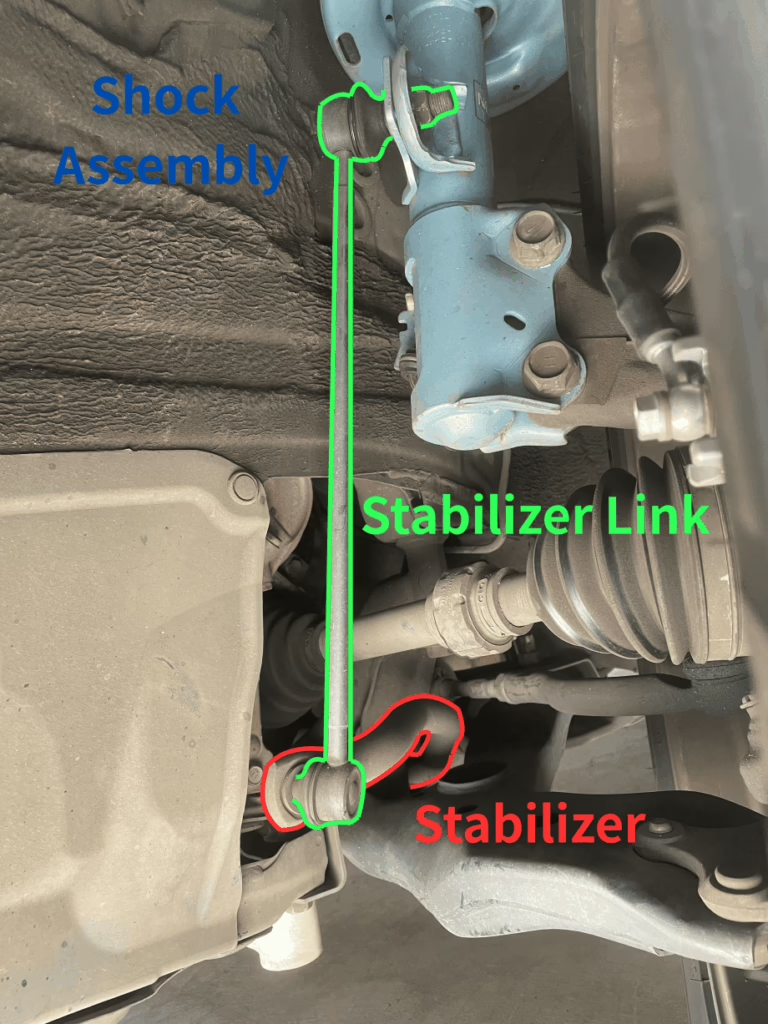Stabilizer bar helps vehicles to keep level, especially when the car is turning.
- Stabilizer is a metal bar that uses torsion to prevent vehicle body roll.
- Stabilizer only works when two wheels are at different heights.
- T.G.Q discourage any modifications to the stabilizer, as the effects can be intense. Unless the mods are perform by the professional technician.
- The stiffer stabilizer loses grip on the affected axle but increases grip on the opposite axle.
- The softer stabilizer increase grip on the affected axle but decreases grip on the opposite axle.
Others name of stabilizer
- Stabilizer has a lot of names, these include
- stabilizer
- stabilizer bar
- anti roll bar
- sway bar
- roll bar
- anti sway bar
What Do Stabilizer Bars Do?
The stabilizer helps keep the car stable during cornering by preventing excessive body roll. Too much body roll can reduce handling performance and make the ride uncomfortable for passengers.
Stabilizer bars Characteristic?
Stabilizer is a U-shaped metal tube. If we fix the middle of the stabilizer and lift one end upward, it undergoes torsion when force is applied. It then naturally attempts to return to its original position. This is the characteristic of the u-shaped metal bar.
How does the stabilizer work on my car?
For example, when a car turns left, inertia causes the vehicle to roll. As a result, part of the car’s weight shifts from the inner wheels(left) to the outer wheels(right).
Now, the outer side of the vehicle bears more weight, causing the suspension to compress. Meanwhile, the inner side loses weight, allowing the suspension to extend. Moreover, body roll changes the control arm angles, allowing the wheels to maintain contact with the road. Normally, the outer (right) control arm is lifted, while the inner control arm moves downward.
The stabilizer bar is connected to both control arms. From the diagram, we can see that when the stabilizer moves upward, the control arm also moves upward. On the other hand, if the inner end of the stabilizer drops, the inner control arm drops as well.
Now, one end of the stabilizer moves upward while the other moves downward. This creates torsion, causing the stabilizer to twist. Obviously, this U-shaped metal bar doesn’t like twisting. So, the stabilizer takes the force generated by the tilt and converts it into a restorative force, allowing it to return to a neutral position.
As a result, for the lifted control arm (outer), the stabilizer will try to push it back down. Meanwhile, for the control arm that just moved downward (inner), the stabilizer will work to pull it back up. This reduces body roll, helping the vehicle return to level position. This is how a stabilizer works.
Where is the stabilizer?
The stabilizer is part of the suspension system. It is usually positioned on the vehicle chassis, with its center secured to the subframe using bushings. The two ends are then connected to the lower control arms of the shock assembly via stabilizer links.

Stabilizer components
Stabilizer
Usually, a stabilizer is a hollow metal tube that is processed into a U-shape. Whether it’s an OEM or aftermarket part, the main reason for different stabilizer designs today is to fit within the car chassis. However, excessive bends can increase manufacturing complexity and cost.
Additionally, aftermarket parts manufacturers offer solid stabilizer bars. Nonetheless, According to an experiment by T.G.Q, a solid stabilizer with the same dimensions increases strength by 5% but adds over 40% more weight. This has a significant impact on vehicle light weighting. Normally, if a stabilizer has not been damaged in a collision, it will never break and should not need replacement.
Stabilizer bushing
To ensure that the force generated by torsion is efficiently transmitted to the wheels, securely mounting the stabilizer is fundamental. Any unwanted movement in the stabilizer can lead to energy loss, reducing its effectiveness.
Therefore, automakers typically place two bushings in the middle of the stabilizer to attach it firmly to the vehicle. Some stabilizer mounts are equipped with metal brackets, further reinforcing the attachment. Although stabilizer mounts rarely fail, they still require replacement. Their lifespan is approximately 100,000 miles.
Can I consider torsion beam suspension as a huge stabilizer?
Yes, you can. Since torsion beam suspension and stabilizer bars operate on the same principle, they both make use of the physics of torsion. In fact, this is a very interesting question. Stabilizers are usually found in independent suspension systems. Independent suspension allows the wheels to maintain maximum contact with the road in any condition, which helps increase grip. However, because the left and right wheels can move independently, this increases body roll. Therefore, stabilizers were introduced. By using a stabilizer, the two wheels are connected, preventing excessive movement.
Modification?
Did you notice? Using a rod to connect the wheels is essentially the same concept as a torsion beam suspension. This means that if you spend $300 to upgrade your stabilizer without proper calculations, you might unintentionally turn your superior independent suspension into a dependent suspension. As a result, this modification could be considered a negative upgrade.
Conclusion
Lastly, adjustable sway bar links and stabilizer modifications are another very important topic for certain vehicles. However, due to the length of this passage, we will discuss this in another article later.
References
T.G.Q R&D
T.G.Q Sales
